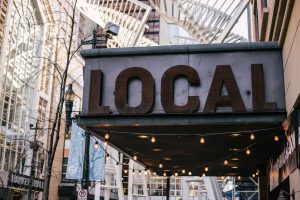The world of SEO is changing because more and more users turn to their mobile phones for information. Because we can access information on the go, we’re using smartphones to look for lunch spots while we’re at work, a mechanic when we’re at home, and for hot night clubs when we’re traveling.
Mobile-first searches have made location-based search much more common. In fact, according to the LSA Local Mobile Search Study, people use their mobile devices almost exclusively for location-based information.
Users want local information, and they want it immediately. Brands that fill this need are getting ahead with geo-targeted SEO practices, while those that overlook location-based search are getting further behind.
Location-based search is our new reality, but few brands have pivoted to embrace local search practices. This is your opportunity to reach both new and existing customers in an affordable, effective medium that they’re already using.
What is Location-Based Targeting?
Today’s search environment means you can reach millions of people in Mongolia if you want. But will those international searches get results for a hairdresser in Spokane? Of course not!
That’s why location-based SEO targeting is so important. If you aren’t an international or remote company, you rely on getting local customers in the door. Location-based search (also known as geotargeting) gets more customers to your brick and mortar location by optimizing content for users in a geographical area.
If you’re selling purses in St. Louis, location-based SEO gives you a framework to adjust your SEO to appeal to customers in St. Louis instead of irrelevant customers in, say, New York City. Geotargeting means you can attract the right customers and skip over irrelevant customers, making your marketing more relevant.
Location-based results are getting so popular with consumers that they’re the default for search engines like Google. If you type “food” in Google Maps, it will automatically pull up nearby restaurants. But even then, there’s a lot of competition at the local level. How can your hair salon stand out from the dozens of other hair salons in your area?
4 Ways to do Location-Based SEO
Location-based SEO is the answer. This SEO approach is easy to implement and only requires a few small tweaks to your existing SEO strategy, too. Follow these 4 tips to get more organic traffic to your site and customers in the door.
1. Use Local Keywords
What keywords are you targeting right now? Is it vague terms like “bakery” or “boutique?” These terms are too broad to get results with local SEO.
Instead, target specific, long-tail keywords that relate to your location. Include your city, state, ZIP code, or part of town in these queries. For example, “bakery” would become “Texas bakery,” “Austin, TX bakery,” “73301 bakery,” or “downtown Austin bakery.” These terms will have lower search volumes, but they’re so specific that they’ll bring the right kind of traffic to your site and store.

2. Fill Out Google My Business
Google My Business (GMB) is one of the most powerful tools at your disposal for location-based targeting. GMB automatically optimizes you for mobile local searches, especially for queries from Google Maps or voice assistants.
Make sure you follow GMB best practices, such as:
- Fill out all information
- Upload quality photos
- Mention your location several times in the listing
- Use your location-based keywords in your profile
- Encourage customers to leave honest reviews
Now, make sure that your GMB information matches the information on other location-based search sites, like Yelp or Yellowpages. These are other great traffic sources, and search engines use them to verify that your business is legitimate.
3. Write Location-Centric Content
Remember, content is king when it comes to SEO. You can’t use generic keywords on your site if you need to bring in more local traffic. If you want to stand out to users in Minneapolis, you need content related to Minneapolis on your website.
That’s not difficult if your business has just one location. But how do you tackle writing content for every location where you have a storefront?
It’s hard work, but you’ll need to write unique landing pages with content tailored to every geographic location. So if you have 50 locations in the US, you would need to write a landing page for every location. And don’t try to create a content template for copy-pasting landing page. This content has to be unique, otherwise Google will give you a duplicate content penalty.
With that said, don’t try to overhaul your content all at once for 50 locations. Choose your top 3-5 locations and optimize those first. As you learn more about local SEO, you can expand your efforts for additional locations.
4. Geo-Targeted Paid Ads
Once you’ve optimized your organic strategies with content and keywords, paid ads are the next step. This sounds counterintuitive, but it’s a well-known phenomenon in marketing that paid and organic strategies complement each other.
SEO and paid advertising go hand in hand, boosting each other’s efforts. When you create a paid campaign for a certain geographic area, search engine algorithms pick up on that. Over time, they’ll display your site in organic searches for location-based queries in your target locations.
If you haven’t tried them already, Google Ads and Facebook Ads have great geotargeting capabilities. You can target by country, state, municipality, ZIP code, and more. This is perfect for limiting where your ads display. You can even add negative location targeting to your campaign, preventing your ads from displaying to users in certain locations.
The Bottom Line
Who said physical commerce is dead? Customers want to buy from businesses close to them. Switch up your SEO strategy to include local geotargeting. That’s going to make your business more competitive on the local stage and get more customers into your brick and mortar location.
But we know that SEO can be daunting for business owners. Give Logical Media Group a shout. We’ll handle the SEO and you can get back to focusing on what matters: your business.








